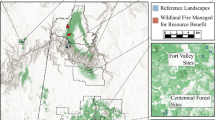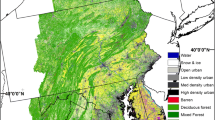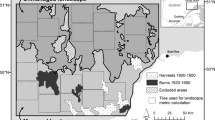Abstract
A continuing discussion in the field of ecology and forest management concerns the implications of clearcutting as a functional replacement for wildfire in disturbance-driven ecosystems. At the landscape level, spatial pattern has been shown to influence many ecologically important processes. Satellite imagery allows the evaluation of structural patterns created by alternative forest management activities at broad scales. In Northwestern Ontario, both clearcutting and wildfire have occurred over large contiguous areas. Spatial characteristics including composition, patch size, patch shape, and interspersion were calculated from classified Landsat Thematic Mapper (TM) data at two thematic scales and used to compare post-wildfire and clearcut landscapes. Patches in the clearcut landscape were found to be larger in size, and had a more irregular shape than those in the wildfire landscape. Differences in landscape structure were much more pronounced at broad scales than at fine thematic scales.
Similar content being viewed by others
References
BakerW.L.: 1993, ‘Spatially heterogeneous multi-scale response of landscapes to fire suppression’, Oikos 66, 66–71.
Beverley, A.M. and Penton, P.G. (eds.): 1989, ELAS Science and Technology Laboratory Applications Software, Volume II, Users Reference, NASA Report No. 183.
Ducks Unlimited: 1991, DISPlay TRAIN EDIT: A User s Reference Guide. Habitat Inventory and Evaluation, Ducks Unlimited, Inc., Memphis, Tennessee, 69 pp.
ERDAS: 1991, ERDAS Version 7.5, Field Guide, Atlanta, Georgia, 394 pp.
FranklinJ.F. and ForemanT.T.: 1987, ‘Creating landscape patterns by forest cutting: ecological consequences and principles’, Landscape Ecology 1, 5–18.
Gluck, M.J.: 1994, ‘An evaluation of remotely sensed wetland mapping’, M.Sc.F. Thesis, Lakehead University, Thunder Bay, Ontario, 79 pp.
HallF.G., BotkinD.B., StrebelD.E., WoodsK.D. and GoetzS.J.: 1991, ‘Large-scale patterns of forest succession as determined by remote sensing’, Ecology 72, 628–640.
HessG. 1994, ‘Pattern and error in landscape ecology: a commentary’, Landscape Ecology 9, 3–5.
HollingC.S.: 1992, ‘Cross-scale morphology, geometry and dynamics of ecosystems’, Ecological Monographs 62, 447–502.
LevinS.A.: 1992, ‘The problem of pattern and scale in ecology’, Ecology 73, 1943–1967.
McGarigalK. and MarksB.J.: 1993, ‘FRAGSTATS: spatial pattern analysis program for quantifying landscape structure’ Unpubl. software, Dep. Forest Science, Oregon State University, Corvallis, Oregon, 62 pp.
MladenoffD.J., WhiteM.A., PastorJ. and CrowT.R.: 1993, ‘Comparing spatial pattern in unaltered old-growth and disturbed forest landscapes’, Ecological Applications 3, 294–306.
RosenfieldG.H. and Fitzpatrick-LinsK.: 1986, ‘A coefficient of agreement as a measure of thematic classification accuracy’, Photogrammetric Engineering and Remote Sensing 52, 223–227.
RoweJ.S.: 1972, ‘Forest Regions of Canada’, Publ. No. 1300, Dep. Environ., Can. Forest Service, Ottawa, Ontario, 172 pp.
SimsR.A., TowillW.D., BaldwinK.A. and WickwareG.M.: 1989, ‘Field guide to the forest ecosystem classification for northwestern Ontario’, Ont. Min. Nat. Resour., Toronto, Ontario, 191 pp.
SufflingR., LihouC. and MorandY.: 1988, ‘Control of landscape diversity by catastrophic disturbance: a theory and a case study of fire in a Canadian boreal forest’, Env. Management 12, 73–78.
SyrjänenK., KalliolaR., PuolasmaaA. and MattssonJ.: 1994, ‘Landscape structure and forest dynamics in subcontinental Russian European Taiga’, Ann. Zool. Fennici 31, 19–34.
TouJ.T. and Gonzalez: 1974, Pattern Recognition Principles, Addison Wesley Co., Reading, Massachussetts, 377 pp.
TurnerM.G.: 1989, ‘Landscape ecology: the effect of pattern on process’, Annu. Rev. Ecol. Syst. 20, 171–197.
TurnerM.G. and RommeW.H.: 1994, ‘Landscape dynamics in crown fire ecosystems’, Landscape Ecology 9, 59–77.
WickwareG.M. and RubecC.D.A.: 1989, ‘Ecoregions of Ontario’, Ecological Land Classification Series No. 26, Sustainable Development Branch, Environ. Can., Ottawa, Ontario, 37 pp.
WilliamsJ.E., WhelanR.J. and GillA.M.: 1994, Fire and environmental heterogeneity in southern temperate forest ecosystems: implications for management’, Austral. J. Bol. 42, 125–137.
Author information
Authors and Affiliations
Rights and permissions
About this article
Cite this article
Gluck, M.J., Rempel, R.S. Structural characteristics of post-wildfire and clearcut landscapes. Environ Monit Assess 39, 435–450 (1996). https://doi.org/10.1007/BF00396160
Issue Date:
DOI: https://doi.org/10.1007/BF00396160




